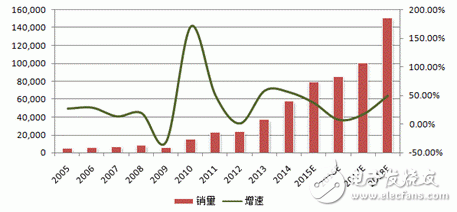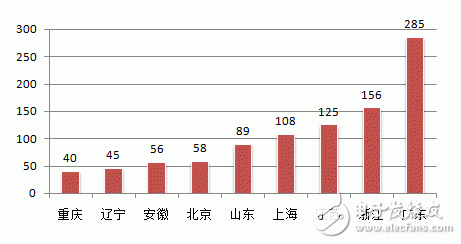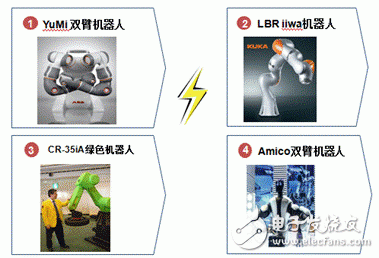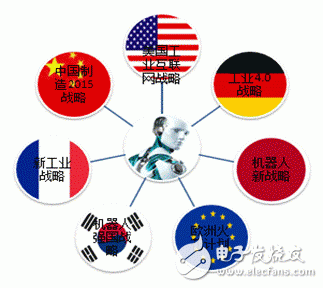Driven by the wave of “machine substitutionâ€, China has been the world's largest industrial robot market for two consecutive years. From the performance of the first three quarters of 2015, China's industrial robot shipments continued to grow at a faster rate in 2015. In terms of the density of robots, China is still below the global average. There is still huge market demand and development potential in China's manufacturing industry. Pan Wei, senior analyst of OFweek Industry Research Center, predicts that China's industrial robot sales will exceed 150,000 units in 2018. By then, the number of Chinese robots will surpass Japan and rank first in the world.
Shipments continue to grow, robotics companies flock to
Driven by the wave of “machine substitutionâ€, China has been the world's largest industrial robot market for two consecutive years. From the performance of the first three quarters of 2015, China's industrial robot shipments continued to grow at a faster rate in 2015. In terms of the density of robots, China is still below the global average. There is still huge market demand and development potential in China's manufacturing industry. Pan Wei, senior analyst of OFweek Industry Research Center, predicts that China's industrial robot sales will exceed 150,000 units in 2018. By then, the number of Chinese robots will surpass Japan and rank first in the world.
Trends in sales of industrial robots in the Chinese market in 2005-2018 (Taiwan)

   At the same time as the Chinese robot industry is advancing, a number of local robot manufacturers including Shenyang Xinsong, Eft, Guangzhou NC, Xinshida and Eston have begun to emerge. According to the statistics of the OFweek Industry Research Center, as of the end of December 2015, the number of domestic robot companies reached 1,026. Among them, the number of robot manufacturers gathered in Guangdong Province reached 285, followed by 156 in Zhejiang Province, ranking second; other regions such as Jiangsu, Shandong, Shanghai, Beijing, Anhui, Liaoning and Chongqing reached 125, 89 and 108 respectively. Home, 58 homes, 56 homes, 45 homes and 40 homes.
However, compared with foreign-funded manufacturers, domestic robot brands have a very large gap in terms of enterprise scale, technical strength, talent team, industry experience, and brand influence. Most domestic enterprises still stay at the stage of imitation and assembly. There are not many enterprises that have independent research and development capabilities, and their core competitiveness is not strong.
Number of Chinese robot companies (home)

Foreign brands attacking the city, the performance of domestic brands is worrying
With the gradual opening of the market, foreign brands have extended their reach to all corners of China. In particular, in 2015, major foreign-funded companies frequently operated, significantly accelerating the strategic layout of the Chinese market. The first KUKA Robot Engineering Center signed a contract to settle in Shunde, after which ABB set up a wholly-owned subsidiary in Zhuhai and launched a robot application integration business. And Yaskawa Electric has joined the home appliance giant Midea Group in August to fully enter the 3C electronics manufacturing market in China's home appliance manufacturing industry. Fanuc plans to set up the FANUC Robotics Engineering Application Center in the Central European Center. At this point, the four giants in the field of KUKA, ABB, Yaskawa Electric, and FANUC Robotics have all been in place, and the sword refers to China's huge manufacturing market.
At the same time, the operating conditions of domestic manufacturers are worrying. According to the statistics of the OFweek Industry Research Center, in 2015, the scale of the Chinese robot industry's ontology business showed an overall growth trend. In the first half of the year, more than 80% of the vendor's ontology business grew year-on-year, and only 20% of the manufacturers declined year-on-year; but from the perspective of profitability The loss of the robot body business is as high as 70%. In other words, more than 70% of the company's ontology business is at a loss.
Pan Wei, a senior analyst at the OFweek Industry Research Center, believes that despite the vigorous promotion of national policies, the scale of domestic robot manufacturers is expanding, but the lack of core parts technology leads to high production costs and the company's profitability is not optimistic. Moreover, in response to the newly emerging domestic brands, foreign manufacturers have adopted price reduction methods to further weaken the market competitiveness of domestic robots. Pan Wei expects that in 2016, the competition in the field of robotics will become more and more fierce, and most domestic OEMs will struggle at the break-even point.
Robots enter the 2.0 era, human-computer collaboration becomes a hot spot
In terms of intelligence, the robot has two attributes, one is the machine attribute and the other is the person's attribute. The first generation of robots or robots in the traditional sense are more biased towards machine attributes, that is, as a special machine to replace human work, mainly to expand human muscle function and do some physical work, such as handling, yarding.ç¹, welding, spraying, assembly, etc. Some heavy, monotonous, and boring types of work that require manpower to complete. The first generation of robots have a common feature. They often only work in a structured work environment, that is, they can only do some programmatic, repetitive and prescriptive work in the case of pre-programming. From the point of view of function realization, most robots lack the environment-aware system, visual function and force-sensing function, and have no tactile function. Just like people have no eyes and no nervous system, they can't feel the real-time changes of the external environment. Communicate and communicate with the outside world, so it can not adapt to the complex non-structural environment and independent work under the space.
In addition, at the level of flexibility and dexterity, the robot's operational capabilities have yet to be further improved, especially in the assembly and production of consumer electronics such as smartphones, notebooks and tablets. On the one hand, the existing robot products cannot meet the technical requirements of the above new fields in terms of accuracy and performance; on the other hand, as the life cycle of 3C consumer electronics manufacturing products becomes shorter and shorter, the robots are re-switched in the production line mode. Flexible production and flexible manufacturing also place higher demands. Safety is also one of the most important issues for robots. At present, most of the robots work in the fence and are isolated from others. In the future, robot trends will urgently solve the problem of human-machine coordination, especially in terms of how to ensure human safety.
Human-machine collaboration robot representative product

Source: OFweek Industry Research Center
Looking back on 2015, the concept of man-machine cooperation has already stood on the cusp. In particular, at the Shanghai Industrial Fair, new products related to collaborative robots have made their debut and become the focus of the industry. Collaborative products that have appeared on the market mainly include Uniro Robot, ABB dual-arm robot YuMi, KUKA's iiwa robot, and FANUC's CR-35iA green robot. Such robots generally have a safety function, and once they are detected, they stop working immediately, and the thrust of the person will be cleverly avoided. From the perspective of the evolution path, the robot is moving towards the 2.0 era and is developing in the direction of human-computer interaction, human-machine communication, and human-machine integration.
Make a promise for ten years to build a strong country
In 2015, China's manufacturing industry promised a commitment spanning ten years. The debut of "Made in China 2025" is actually to match Germany's Industry 4.0 and the US's industrial Internet, and at the same time outline the blueprint for China's manufacturing industry in the next 10 years. With the "Made in China 2025" landing, the top ten key areas including robots have risen to the national strategy, and robots have become synonymous with high-level, and have received hot topics focused by domestic media.
Relevant robotics strategies in countries around the world

Source: OFweek Industry Research Center
However, looking at the global manufacturing industry, Germany already has industry 4.0 industry benchmarks including the Siemens Amberg factory and the Bosch Rexroth Humboldt factory. GM and other US companies are also aggressively piloting the industrial Internet sector, with a first-mover advantage. The developed countries are already in the industrial 3.0 stage and are making great strides toward the higher level of Industry 4.0, while the Chinese manufacturing industry is still catching up on the road of Industry 2.0 or Forward Industry 3.0.
In the next 10 years, adjustments and opportunities will coexist. It is not only the golden period for the transformation and upgrading of China's traditional manufacturing industry and the promotion of global manufacturing competitiveness. It is also a historical development opportunity for China to realize the “overtaking of the curve†and the dream of manufacturing the country through “smart manufacturingâ€. Global manufacturing competition has begun, and a new generation of high-tech represented by robots will become a new magic weapon for technological innovation and industrial transformation. Who can preempt the jewel of the top of the manufacturing crown, who will be able to win the initiative of the future manufacturing industry!
The Industrial Relay is an automatic switching element with isolation function. It is widely used in remote control, telemetry, communication, automatic control, mechatronics and power electronics. It is one of the most important control components.
Our company's Industrial Relay are mainly devided into these three series,with good quality and most competitive price,:
1.Thermal Overload Relays
Industrial Relays,Thermal Relay,Overload Relay,Electronic Overload Relay
Ningbo Bond Industrial Electric Co., Ltd. , https://www.bondelectro.com